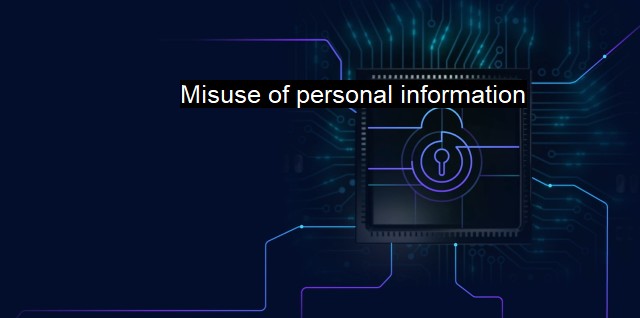What is Misuse of personal information?
Protecting yourself from Misuse of Personal Information in Today's Digital Age: Lessons Learned from the Equifax Data Breach and More
"Misuse of personal information" is a broad term that describes the intentional abuse or unauthorized treatment of personal data usually by systems or individuals capable of processing such data illegally. Insecure personal information can lead to several detrimental consequences, such as identity theft, financial losses, emotional distress, and, in extreme cases, personal harm. "misuse of personal information" implies the abuse of this information via digital platforms.The generation and circulation of personal information have become virtually unavoidable in our digital age. Almost everyone dispenses an overwhelming amount of individual data while using digital devices and the internet. This personal data might comprise personal identifying information (PII) such as names, addresses, phone numbers, social security numbers, bank information, passwords, etc. Other types of personal data include digital footprints such as search records, emails, social media posts, digital transactions, and much more. Although use of personal data facilitates numerous government, business, and individual transactions, it also has exposed individuals to potential misuse of personal data cyber threats.
The potential ways that this information can be misused are numerous and diverse. For instance, cybercriminals can steal someone's identity, creating false credit card accounts, and racking up enormous debts on the victim's behalf. Some could misuse it to gain unauthorized access to online accounts such as emails, social media profiles, bank accounts, etc., and conduct activities that could bring distress, damage reputation, or financial loss to the victims. Some criminals generate sophisticated malware, including ransomware, viruses, trojans, and spyware, that not only infiltrate network security but also make off with personal information for various nefarious activities.
These forms of misuse of personal information point to the significance of cybersecurity and antivirus measures. Cybersecurity involves applying measures to prevent, detect, and respond to these cyberattacks and data breaches. Antivirus software, a critical aspect of cybersecurity, serves as a gate to shield network security from malicious software attempting to access the system.
The misuse of personal information doesn't only harm individuals but also organizations. For instance, a business that suffers a data breach could risk losing their customers' trust and experiencing irreparable brand damage. More so, lawsuits could result from such data breaches, potentially leading to hefty fines and an overall decline in business prospects.
All hope is not lost as reputable antivirus software provides defense mechanisms to keep individual and organizational data protected. Antivirus software scans and monitors digital systems relentlessly to spot and block a wide range of malware before they hit the system or network. It can single out potentially harmful activities and separate infected files that could harm the system. A report by the antivirus helps understand the network's health and procedure to improve it further.
Maintaining strong cyber resilience also involves adopting smart cybersecurity habits like filling out only necessary online forms, using complex and unique passwords, installing recommended security updates and patches, regular system backup, being wary of phishing attempts, avoiding unknown email links or attachments, among others.
The misuse of personal information is a growing concern in the digital age. It exposes individuals and organizations to extensive harm and disadvantage. The need for robust cybersecurity measures and effective antivirus software can never be overstated in keeping personal information safe and prevent its misuse. They stand as a crucial line of defense in protecting the privacy, integrity, and accessibility of precious information. It’s a shared responsibility—every user should strive to protect their personal data online while hoping that corporations control it appropriately.

Misuse of personal information FAQs
What is meant by the misuse of personal information in cybersecurity?
Misuse of personal information in cybersecurity refers to the unauthorized collection, storage, or use of personal information by hackers or cybercriminals. It can include stealing personal data such as social security numbers, bank account information, or credit card details.How can I protect my personal information from being misused in cybersecurity?
To protect your personal information from being misused in cybersecurity, you should ensure that you have a strong and unique password for all your online accounts. You should also be careful while sharing personal information online or while downloading attachments from unknown sources. Additionally, you should install and regularly update a reliable antivirus software to protect your devices from cyber threats.What should I do if I suspect that my personal information has been misused in cybersecurity?
If you suspect that your personal information has been misused in cybersecurity, you should immediately notify your bank or credit card companies and request them to freeze your accounts. You should also report the incident to the relevant authorities such as the police or the Cybersecurity and Infrastructure Security Agency (CISA) and seek their assistance to secure your personal information.What are the consequences of misusing personal information in cybersecurity?
Misusing personal information in cybersecurity is a serious offense and can lead to severe consequences. Cybercriminals who are caught misusing personal information can face fines, imprisonment, and even permanent criminal records. Additionally, the victims of personal information misuse can suffer financial losses, identity theft, and reputational damage.| | A | | | B | | | C | | | D | | | E | | | F | | | G | | | H | | | I | | | J | | | K | | | L | | | M | |
| | N | | | O | | | P | | | Q | | | R | | | S | | | T | | | U | | | V | | | W | | | X | | | Y | | | Z | |
| | 1 | | | 2 | | | 3 | | | 4 | | | 7 | | | 8 | | |||||||